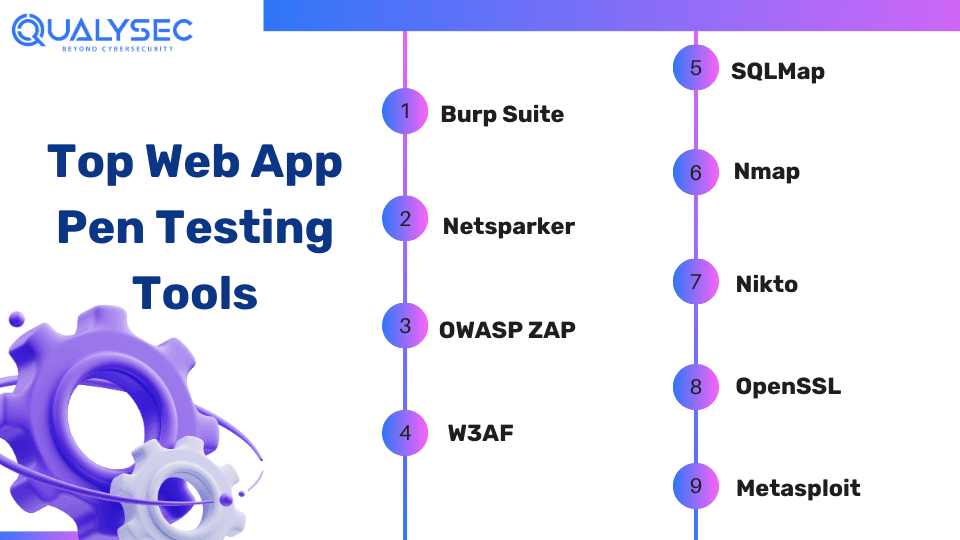In an increasingly interconnected world, web application penetration testing is essential for guaranteeing the security of online systems. Testers assist in strengthening an organization’s security by identifying vulnerabilities like SQL injection and cross-site scripting. In this blog, we will understand the principles of pen testing, important features to look for in web app pentesting tools, and the best penetration testing methods. Hence, knowing these concepts is crucial to protecting sensitive data and preserving user confidence.
Understanding Web Application Pentesting
Web application pentesting (or penetration testing) is essential for testing the security of web-based systems by simulating real hacking behaviors. It detects flaws like weak authentication, misconfigurations, and cross-site scripting. Moreover, through a structured process, testers try to exploit these vulnerabilities to gain unauthorized access to the data or manipulate it.
The aim is to determine and fix security vulnerabilities before they are used by real attackers, protecting the confidentiality, integrity, and accessibility of the application. Furthermore, this testing strengthens the defense systems, protects sensitive information, and earns users’ trust. Continuous monitoring is fundamental to tackling the developing threats and therefore guarantees strong web application security.
Top Features That Every Web App PenTesting Tools Should Have
Here are the essential features that every web app pentesting tools should have:
1. Vulnerability Detection:
The top pen testing tool should be able to identify vulnerabilities in web applications which include cross-site scripting, SQL injection (XSS), and CSRF (Cross-Site Request Forgery).
2. Custom Scanning
The pen tool must allow the users to customize the scanning process as per their specific needs. Additionally, this includes defining which parts of the application to target and setting the depth and intensity of scans.
3. Reporting
Detailed reporting is essential for pen testing tools. Users must be able to provide detailed reports outlining the vulnerabilities discovered throughout the scanning process, as well as recommendations for remedy.
Do you want to know what the comprehensive report looks like? How it will guide you to get the best web penetration testing? You have to click and download the sample web app pen testing report.
Latest Penetration Testing Report

4. Support For Different Platforms
As web applications can be developed with several technologies and frameworks, an appropriate pen testing tool should support a diverse range of platforms, languages, and frameworks. This, therefore, means it can be used to test applications regardless of their fundamental technology.
5. Ease of Use
A pen testing tool should be easy to use and intuitive, especially for people with less security testing knowledge. This includes elements such as a simple and user-friendly interface, as well as useful documentation and support materials.
Top Web App Pen Testing Tools
1. Burp Suite
Burp Suite is one of the most popular and well-known vulnerabilities discovering penetration testing tools that identify the security weaknesses in web applications and network resources. It enables the interception of communications between a browser and the targeted application, which is why, the tool is a proxy-based cyber tool.
2. Netsparker
Netsparker provides a complete testing solution for web applications as a web-based or self-hosted service. With its capability to detect vulnerabilities and verify them using proof-based scanning technology, Netsparker nullifies the need for manual verification and eliminates the chances of false positive results, thus becoming a one-stop solution for web application security requirements.
3. OWASP ZAP
Open Web Application Security Project (OWASP) Zed Attack Proxy (ZAP) is a widely recognized open-source web app penetration testing tool. It is an automated scanner that executes audits at both the development and testing phases of the web apps. ZAP is also appropriate for experienced pen testers to perform manual attacks.
4. W3AF
W3AF (Web Application Attack and Audit Framework), is an open-source web application security scanner. It is a security vulnerability scanner along with an exploitation tool developed to combat web application vulnerabilities. Therefore, throughout penetration testing projects, w3af gives crucial information regarding security hazards, allowing it to be an irreplaceable tool for any security expert.
5. SQLMap
SQLMap is an open-source and one of the most popular automation tools in the world of penetration testing. Moreover, this tool is used for detecting and exploiting SQL injections and hacking databases. Additionally, it is equipped with a strong detection engine and a range of tools and techniques (such as database fingerprinting, data fetching, file system access, and operating system command execution) making it the perfect solution for penetration testers.
6. Nmap
Nmap (Network Mapper) is a well-known open-source system for network exploration and security auditing. It is a tool used by network administrators and penetration testers to acquire information about network hosts, services, operating systems, firewalls, and any other attributes through its powerful scanning capabilities.
7. Nikto
Nikto is a popular open-source web server scanner that conducts a thorough examination of many web server components. Furthermore, it checks server settings, like the existence of many index files and HTTP server options, and can determine the type of web server and software.
8. OpenSSL
OpenSSL is a software library that is widely used for delivering secure communication over computer networks. It protects against eavesdropping and also enables the identification of entities at the other end of the communication. It is implanted in almost all Internet servers and, therefore, responsible for the combined hosting of HTTPS websites.
9. Metasploit
Metasploit is an open-source, modular platform for performing vulnerability scanning and an effective exploitation framework. It is widely used for ethical hacking and penetration testing tasks, enabling the simulation of real attacks in the controlled space. The new version of Metasploit Framework 5.0 offers improved security testing options and makes pen testing more refined.
Does your company need web application penetration testing? Consult our knowledgeable security professionals for free right now!
Talk to our Cybersecurity Expert to discuss your specific needs and how we can help your business.
Criteria for Selecting the Best Web App Pen Testing Tools
When selecting the best web app pen testing tools, consider factors like versatility, ease of use, and reliability.
- Look for tools with comprehensive scanning capabilities to detect vulnerabilities across various layers.
- Ensure compatibility with different web technologies and programming languages.
- Prioritize tools with reporting features for clear documentation of vulnerabilities and recommended fixes.
- Additionally, assess community support and regular updates to stay abreast of emerging threats.
- Lastly, consider the tool’s cost-effectiveness and scalability to meet the needs of different projects and team sizes.
Overall, choose tools that offer a balance of functionality, usability, and support.
What Are the Top Penetration Testing Techniques?
Penetration testing is the process of finding vulnerabilities in a digital system. Here are the top techniques:
1. Black Box
This emulates an attacker with no prior information about the system. It checks the level of the system’s ability to resist real cyberattacks.
2. White Box
In this technique, testers have a full understanding of the system’s architecture. They inspect vulnerabilities from an insider’s viewpoint.
3, Gray Box
This technique combines aspects of black-and-white box testing and needs a partial understanding of the system. Testers may have restricted information, simulating an environment in which attackers have access to some insider knowledge.
Each method has its unique strengths and weaknesses, and therefore, using a set of techniques will give a good picture of the level of its security standpoint.
Conclusion
Web application penetration testing is crucial to protect digital assets from malicious attacks. By using high-quality penetration testing tools and techniques, organizations can secure their web applications and eliminate possible vulnerabilities. However, choosing the best web app pentesting tools depends mainly on the factors of versatility, user-friendliness, and compatibility with a variety of web technologies.
Furthermore, using a variety of penetration testing techniques, such as black box, white box, and gray box, provides a thorough evaluation of security measures. Moreover, investing in thorough pen testing guarantees that web applications are secure, confidential, and accessible, nurturing user trust and confidence.
FAQs
Q. What is website application penetration testing?
A. Web application penetration testing is essential for testing the security of web-based software by simulating real attacks. It detects flaws like weak authentication, SQL injection, and cross-site scripting.
Q. Which tool is used for web application testing?
A. Some of the tools used for web application testing are:
- BurpSuite
- Netsparker
- SQLMap
- Metasploit
Q. Why is web app testing important?
A. Web app testing is important to find and fix security vulnerabilities before real attackers use them. Furthermore, this testing process strengthens the defense systems, protects sensitive information, and earns users’ trust.

































































































































































































































































































































0 Comments